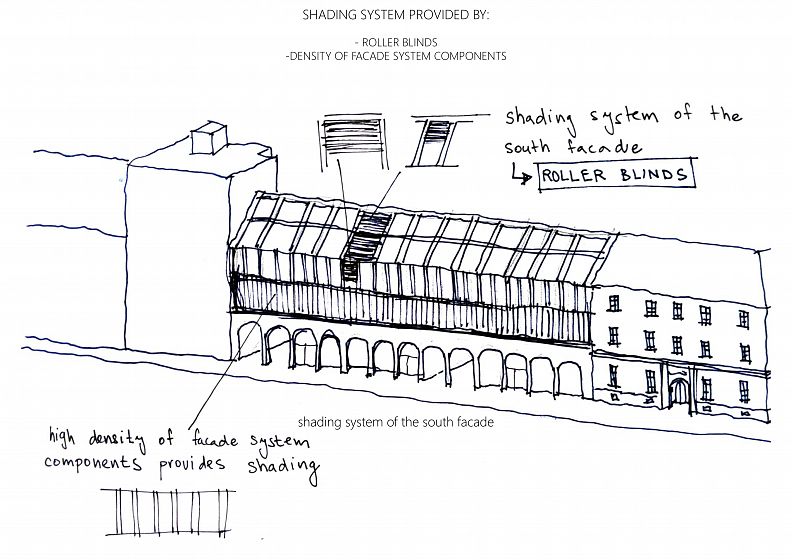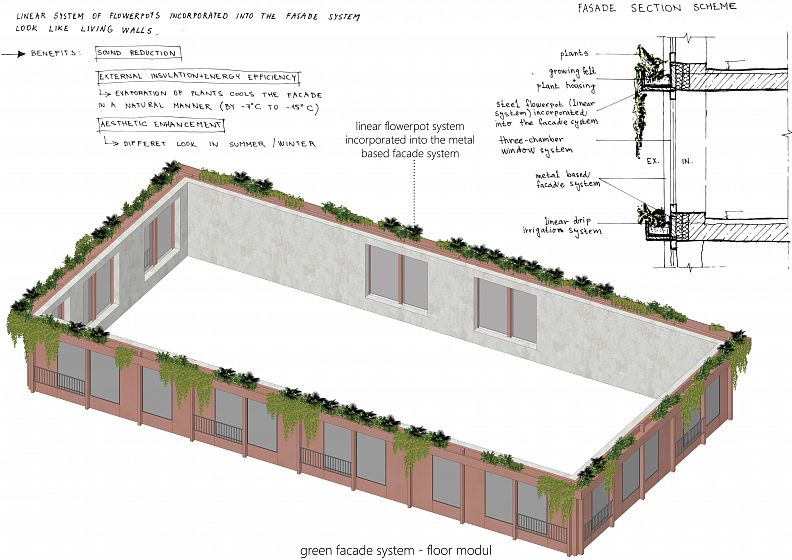City Palace, Bratislava

Project idea
The site is accessible from Špitálska Street, located in Old Town of Bratislava, and is used as a surface car park. Spatially, it is defined by the complex of the hospital and the Church of St. Ladislav (1830-1831, Ignatz Feigler Sr.), an adjoining apartment building, the Church of St. Elizabeth and the complex of buildings of the Oncological Institute of St. Elizabeth. The proposed city palace should represent an interest in knowledge from the historical development of the typology of city palaces and their urban values with a significant overlap into public space. The assignment has the ambition to bring a new layered structure of spaces and functions into a rare historical context.
The main idea of the urban concept is to bring back life to the city block’s courtyard so that it becomes more hospitable for it’s users. At the same time, to become a place to relax, a place with diverse views, a kind of oasis in the bustling urban jungle. As well as an oasis for the hospital. In 1895 there was a green park in the courtyard. However, today’s situation looks completely different. Most of the areas are used for surface parking and even a small part of the courtyard, which should serve as a park for the hospital, is neglected. The proposal seeks to restore at least part of the original greenery that once existed here. It supports the greenery of the city in the form of a landscape park, as well as the greenery incorporated into the buildings.
The courtyard is cleaned from temporary pavilions and various “postiche” buildings. Instead, there is a new park, an “oasis”. The proposed objects, together with the existing ones, set aside the zones of the new park. Each zone can have it’s own character, which will depend on the functions / operations that will follow it. Diversity, that is what characterizes the proposed space of the courtyard. However, the zones / spaces do not have their “final” form in this proposal. It is an eternal, unceasing process of development (like the city itself). Spaces adapt to new functions, desires and needs of their users, and they are the ones who will influence their development and diversity.
In the architectural concept I follow up with the theme of diversity. The proposal does not consist of one compact, but of several separate objects. There is a kind of coexistence of “old and new” architecture. Objects do not create a single complete image, nor do they compete with each other. There is no dominant among them. The new city palace is defined by contrasts that create a range of contradictions.
Project description
The city palace consists of several separate objects, using the principle of connection, continuity, copying or addition of masses to existing deaf facades. However, I respect the historically significant objects included in the city block, and I do not try to compete with them, to exceed them. The new building that fills the gap from the street is continuous in shape of the neighbouring Saint Elisabeth monastery. From the street point of view, both churches remain dominant.
The current parking lot was replaced by the park, so the parking capacity was extended and moved underground, to leave the space for the
park´s greenery and pedestrians. Undreground garage disposes by 369 parking spaces, and serves for the whole city block (including the Oncological Hospital of St. Elisabeth).
The program extends and complements existing functions in the objects of the city block. It includes: two separate buildings for administrative, daycare for seniors, temporary living apartments for doctors, prevention center and other associated functions like bistro, reastaurant, private physiotheraphy ambulance in the parterre of the apartment building or the canteen for employees located in the parterre of preventive center with the kitchen supplying also the daycare center for seniors.
Technical information
In terms of construction, the buildings are designed as a reinforced concrete skeleton, the underground floors are based on a reinforced concrete tub. Diversly appearing buildings have in common frame like structure of their facade systems. Materials used for facades are based on fiberbeton for the “administrative 2 building“ and “prevention center“ and calc tuff cladding from local slovak calc tuff, for the representative “administrative 1 building“ in the gapsite. The same material was used for the Hotel Kiev and Prior, both located on the opposite side of Špitálska street, opposite to the new city palace in the gapsite. For the “apartments building“ is used metal cladding, with the flowerpots incorporated into the facade system along the perimeter of every floor - creating verical garden. The “daycare for seniors“ building consist of two parts - the reconstructed one and the new one, with the facade surface from plaster. Since most of the surfaces of the facades are designed as glazed, the addition of shading elements is being considered, especially from the south side and for the roof of the city palace in the gapsite. At the same time, the shading system is of ecological importance, it prevents the building from overheating, as well as it allows the reception of additional heat gains when they are required. The ecological principle is also reflected in the usage of intensive greenery on the roofs and facades, which has positive ecological effects on the surroundings, maintains the ecological balance of the area, prevents the building from overheating from the roof retains precipitation and water.
Co-authors
Under the leadership of: Ing. arch. Maroš Fečík; Ing. arch. Martin Hudec, PhD.; Ing. arch. Katarína Bergerová






































